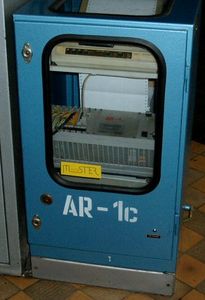THE AR-1C DATALOGGER
GENERAL CHARACTERISTICS
The AR-1c Datalogger was the first polish datalogger and the successor of popular "Karlik" - electromechanical datalogger. The AR-1c was built with use of a microprocessor systems. It was produced and approved (approval feature GM-174/93) in 1993. During the first half the 90s it had been installed in polish mines, then it was succeeded by the more modern and elastic AR-2c Datalogger. The AR-1c Datalogger registered the inputs only on a paper tape of the OKI local printer - it was the most important feature that differed AR-1c from AR2-c Dataloggers. Other features:
- possibility of specific number of inputs registering: 22 binary inputs, 2 acoustic inputs and 2 analog inputs
- small size of the internal memory, which allows only on short-lived turn off a printer
- some mechanical elements of a printer are very sensitive, so the datalogger have to be built in the dustproof case
- the printer is equipped in an alarm, which warns the user before paper would be over
- there is no possibility of connecting the datalogger to central data acquisition
In next years some of AR-1c dataloggers were equipped with an encoder for speed measurement and a LED display.
The AR-1c datalogger was often used because of its simplicity and high reliability. In some mines the AR-1c datalogger is still in use on peripheral shafts.


